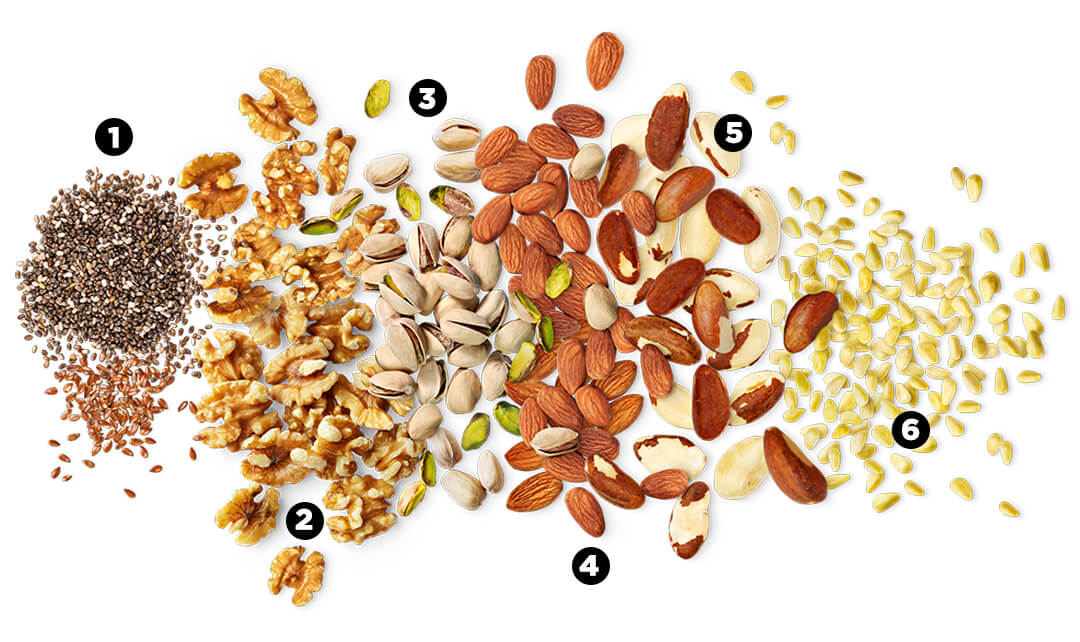HEALTHY YOU
A Tasty Way to Boost Your Brain
Adding more nuts and seeds to your diet may help improve your mood, sharpen your cognition and fend off the diseases of aging
By KELSEY OGLETREE
THERE MAY BE no such thing as a “perfect” food, but nuts and seeds come close. These nutritional nuggets contain omega-3 fatty acids and other unsaturated fats to help reduce inflammation and promote heart health, says registered dietitian Jessica Cording. With 3 to 7 grams of protein per ounce, nuts and seeds help fuel muscle maintenance and repair. They also keep you feeling full, helping with weight management.
But, in addition, these morsels have an unsung superpower: They help protect your brain. In part, that’s due to their mix of healthy fats and antioxidants. But it’s also a function of their fiber content. “Eating enough fiber from food helps maintain a more balanced microbiome, which supports overall physical and mental well-being,” says Uma Naidoo, M.D., a nutritional psychiatrist and author of This Is Your Brain on Food. Because nuts are high in calories, keep your snacking to about 1 ounce (¼ cup) of nuts per day; that’s about 23 almonds or 14 walnut halves. Here are Naidoo’s choices for top nuts and seeds to keep your brain sharp.


1. Chia Seeds and Flaxseeds
CHIA SEEDS and FLAXSEEDS are very rich in omega 3-fatty acids in the form of ALA, or alpha-linolenic acid, which research suggests supports brain health. Use ground flaxseed to maximize your body’s ability to digest it.
2. Walnuts
WALNUTS might be shaped like little brains for a reason: They provide higher amounts of ALA than any other nut. Emerging research also links regular intake of walnuts with a lower prevalence of depressive symptoms and improved mood, says registered sports dietitian Kelly Jones. Like other nuts and seeds, they’re also rich in protein and fiber.
3. Pistachios
Researchers at Loma Linda University found that nuts have a positive impact on the brain’s ability to generate brain waves, including gamma waves, which are critical for cognition and memory. Among the nuts tested, PISTACHIOS had the greatest effect on gamma waves.
4. Almonds
Among all nuts, ALMONDS are by far the most potent source of vitamin E. Low intake of vitamin E has been linked to an increase in dementia risk.
5. Brazil Nuts
BRAZIL NUTS are a great source of selenium, an antioxidant that has been associated with improved brain health, says Cording. (Just one a day will more than cover your daily need of 55 mcg).
6. Pine Nuts
PINE NUTS are rich in a rare and specific fat called pinolenic acid, which has been shown to reduce inflammation levels.
Raw or Roasted?
There’s not a big difference, healthwise, between raw and roasted. “It’s more important that you’re consuming nuts and seeds at all,” says dietitian Jessica Cording.
Dry-roasted nuts, which are roasted without any oil, have a similar nutrient profile to raw. You can dry-roast nuts at home to enhance their flavor and texture; most do well baked at about 300°F until fragrant, about 10 to 25 minutes. (Different nuts cook at different rates.) There’s one caveat, though: “Do not overcook them, as that can reduce their antioxidant potential,” says dietitian Kelly Jones.
Whether you’re buying whole nuts or nut butters, the same rules apply. “Look for products with as few ingredients as possible—ideally just the nuts or seeds,” Cording says. If you see oils (such as palm oil), preservatives or added sugar, keep looking.


WHAT IF I’M ALLERGIC?
An estimated 3.9 million Americans are allergic to tree nuts, including almonds, Brazil nuts, cashews, pecans, hazelnuts, pistachios and walnuts. That doesn’t mean they can’t enjoy similar health benefits by eating seeds, Jones says. “Roasted pumpkin seeds and hemp seeds are excellent additions to oatmeal, salads and side dishes, while flax and chia seeds are great blended into smoothies as well as oatmeal and baked goods,” she adds.
Kelsey Ogletree writes on food and nutrition for Real Simple and other magazines.
Getty Images (10)